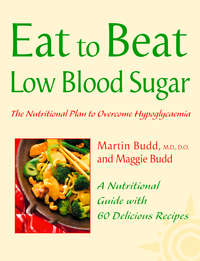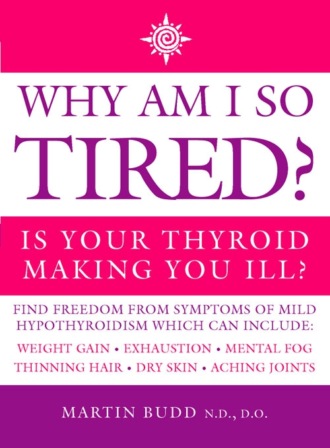
Полная версия
Why Am I So Tired?: Is your thyroid making you ill?


Why am I so Tired?
Is Your Thyroid Making you Ill?
MARTIN BUDD N.D., D.O.

Contents
Cover
Title Page
Acknowledgement
By the same author
Introduction
PART ONE: THE SYMPTOMS
1 ‘What is the Thyroid Gland?’
The Thyroid Gland and Your Body
2 ‘Why do I Feel so Tired?’
The Thyroid Gland and Your Fatigue
3 ‘Why Can’t I Lose Weight?’
The Thyroid Gland and Your Weight
4 ‘Why do I feel so Depressed?’
The Thyroid Gland and Your Emotions
5 ‘Why do I Never Feel Like Sex Anymore?’
The Thyroid Gland and Your Sex Drive
The Thyroid Gland, Menstrual Patterns and PMS
6 ‘Why do I Ache?’
The Thyroid Gland and Your Joints and Muscles
7 ‘Can my Fatigue Affect my Heart?’
The Thyroid Gland and Your Heart
8 ‘Why Won’t my Skin Clear up?’
The Thyroid Gland and Your Skin
Diabetes and Hypothyroidism
Infections and Hypothyroidism
PART TWO: DIAGNOSIS AND TREATMENT
9 Diagnosing Your Mild Hypothyroidism
10 Treating Your Mild Hypothroidism
11 Diagnosing the Causes of Fatigue
Appendix: The Causes of Mild Hypothyroidism
Glossary
Resources
References
Index
Copyright
About the Publisher
Acknowledgement
This book could not have been written without the enthusiastic support of my wife, Maggie.
By the same author:
Low Blood Sugar
Diets to Help Diabetes
Diets to Help Migraine
Recipes for Health: Low Blood Sugar (with Maggie Budd)
Why Can't I Lose Weight
Eat to Beat – Low Blood Sugar
While the author of this work has made every effort to ensure that the information contained in this book is as accurate and up to date as possible at the time of publication, medical and pharmaceutical knowledge is constantly changing and the application of it to particular circumstances depends on many factors. Therefore it is recommended that readers always consult a qualified health specialist for individual advice. This book should not be used as an alternative to seeking specialist advice, which should be sought before any action is taken. The authors and publishers cannot be held responsible for any errors and omissions that may be found in the text, or any actions that may be taken by a reader as a result of any reliance on the information contained in the text, which is taken entirely at the reader’s own risk.
Introduction
My interest in low grade or mild hypothyroidism began in the early 1980s. Following the publication of my first book Low Blood Sugar (hypoglycaemia) in 1981, I was consulted by many exhausted, depressed patients who having read the book were convinced that they had discovered the mystery cause behind their symptoms. However, it soon became apparent to me as I became more familiar with the diagnosis of hypoglycaemia, that approximately one third of the patients did not suffer from low blood sugar, but their fatigue was caused by another illness — undiagnosed mild hypothyroidism.
Hypothyroidism is often missed in patients suffering from fatigue because many of these people do not fit into the medical definition of ‘hypothyroid’; many hypothyroid patients show clear test results under the accepted medical blood tests or do not fit into the typical picture of an overweight, middle-aged hypothyroid sufferer. For example, many young hypothyroid patients are not overweight but underweight. Men and women of all ages can develop thyroid problems, and there are over 100 symptoms caused by thyroid deficiency. The overweight middle-aged female with exhaustion and alopecia may well be the archetypal patient but a ‘typical’ thyroid syndrome does not exist. Each patient can present their own unique symptom picture. Every organ and system in the body can be disturbed when the thyroid is underactive, and a mild thyroid malfunction can give rise to 10-20 different symptoms in each patient. Symptoms as diverse as leg cramps, allergic rhinitis, constipation, period pains and poor memory have all been attributed to hypothyroidism.
Mild or early stage health problems often go undiagnosed as laboratory tests identify only major blood changes. This has led to a situation where many suffer symptoms of illness — but not ‘clinically’ bad enough for a blood test diagnosis to be made.
Blood tests are only a reliable guide to diagnosis when the procedures for testing and the interpretation of the results are standardized. For example, with the diagnosis of diabetes, the test procedures and the normal ranges for blood glucose are internationally recognized. The test results therefore provide a reliable guide to the diagnosis, the severity and the successful treatment of diabetes. Unfortunately, the same cannot be said when testing for thyroid disorders.
In Why am I so Tired? I discuss many of the symptoms, treatments and causes of this underdiagnosed health condition. In Part One I describe how the thyroid influences the body and explain in detail the most common symptoms of untreated hypothyroidism. In Part Two I compare and elucidate the different diagnostic methods and show you some simple diagnostic tests you can carry out easily at home. I discuss both medical and naturopathic treatment and illustrate how diet, exercise and lifestyle changes, can go a long way to relieving your symptoms. Lastly, I discuss many of the underlying causes of a thyroid disorder so you can not only treat your symptoms more effectively, but learn to understand how your body became fatigued. I also discuss some of the different causes and diagnostic techniques for fatigue itself, so that you may begin to treat fatigue even if you feel hypothyroidism may not be the underlying illness.
I hope that with the help of this book you can begin to fight your fatigue and recover your natural health, energy and vitality.
PART ONE
Fatigue and weariness can slowly take over your body. You may find it difficult to motivate yourself, to become excited or express enthusiasm; body and mind are slow and heavy. Some of you may be painfully aware of this change in energy level, others may have experienced tiredness for so long it seems natural and cannot remember a time they felt vital or energetic … if ever.
However, with the guidance of this book you can return to health. Here is the success story of one woman I helped through fatigue, stress and depression to finally recognize and treat her undiagnosed mild hypothyroidism.
Liz’s Story
Liz had felt exhausted for four years. Prior to her total hysterectomy four and a half years ago, she had been a slim, active mother in her early forties with two teenage children and the happy wife of a successful caring husband.
She had hoped that after her hysterectomy she would enjoy a future without the monthly burden of heavy, painful periods caused by endometriosis. However, after three months convalescence, she felt certain that in her own words — ‘something was wrong’. Within six months of the operation, Liz looked a different person. She was 20lb over her normal weight of 125lb, and her usual robust colour was replaced by an unhealthy pallor with dark shadows beneath her eyes. All of which made her look 10 years older than her 46 years. Although Liz was concerned about her looks, she was far more worried about how she felt.
The Tiredness
We all feel tired — or fatigued — now and again. Usually we can put it down to a few too many late nights, or maybe an unexpected stress or illness, maybe even just working too hard. This transient fatigue lifts after a few early nights or a restful holiday. Unfortunately the type of chronic fatigue you might be experiencing does not go away. You may constantly feel tired, your body may feel heavy all the time and simply concentrating on your work or completing the household chores may take all the energy you have. You — like Liz — may be suffering from a type of fatigue which cannot be solved by early nights or a holiday. Liz realized that her energy levels and work capacity compared very unfavourably with her pre-hysterectomy vitality; although, you may not be able to pin down your exhaustion to a single event or cause, you probably realize that you are not your normal, energetic, and happy self.
Liz ached with fatigue. Her neck, shoulders and lower back were stiff and painful. Her hands and feet were always cold and occasionally numb, and dull frontal headaches had become a daily pattern. Far from sleep refreshing her, she felt worse on waking and claimed that she ‘didn’t really surface until mid-day’. The physical exhaustion was accompanied by mental exhaustion, this caused her to feel depressed. Her increasingly poor concentration and memory were the cause of many problems. Although she could remember her childhood with some clarity, her short-term memory was unreliable. She frequently lost her car keys and shopping lists, and missed appointments. On several occasions she could not recall where her car was parked and was obliged to take a taxi home.
The Domestic Stress
For Liz everything was an effort, she felt drained, confused and unhappy. Her exhaustion and depression lead to frustration, irritability, and anxiety. Her husband Mike, found that his business as a garden designer begun to suffer. Liz had looked after his books and accounts for many years, but now her poor concentration and moodiness resulted in lost and dissatisfied clients. Arguments between Liz and her husband became daily events. We can all absorb stress from our partners, and certainly Mike was becoming anxious and increasingly baffled by his wife’s attitude and behaviour.
Their marriage was not helped by Liz’s loss of interest in sex. The sexual side of their partnership had always been mutually satisfying and relaxing, but for Liz this had lapsed under the familiar excuse of ‘too much effort’. For the same reason Liz felt unable to continue the dancing and golf that they had both enjoyed for many years. Mike had complained to his doctor that he thought the hysterectomy had changed his wife’s personality. By the time Liz consulted me her weight had risen to 1701b, being 45lb over her ideal weight.
In addition to her exhaustion and other symptoms, Liz complained that if she did not eat every two or three hours she would tremble and feel dizzy and breathless, and often experienced a sugar craving. Because of this she had increased her meal frequency to include snacks of sugar-rich pastries and drinks. This new habit, coupled with her lack of exercise and general sluggishness, served to further increase her weight.
After four years of ill health, Liz had become trapped in a vicious circle of exhaustion, depression, obesity and anxiety. Her natural optimism and self-esteem were at zero.
When Liz discussed her symptoms with her doctor a few months after her operation, she was told that she was simply suffering the after effects of major surgery, and the consequences of an overnight menopause. He requested a blood screen including full biochemistry, haematology and thyroid profiles. The only test ‘out of range’ was a slightly raised cholesterol. There was no evidence of anaemia and the thyroid hormone levels appeared normal. Liz was told that her blood pressure was also normal, but she was advised to lose weight by reducing the fat and sugar in her diet. She was prescribed a low dose HRT and an antidepressant. Unfortunately after trying several antidepressants and attempting unsuccessfully to diet, Liz was still overweight, depressed and exhausted. Moreover, she was confused, the doctor had said her tests were ‘normal’ and yet she felt far from her ‘normal’ self.
MY DIAGNOSIS
Although the thyroid test showed results within the medically-defined normal range, I considered that Liz had many symptoms that one could attribute to a low grade or mildly underactive thyroid. I therefore requested another thyroid profile (her last test being four years earlier), and instructed her to test her morning temperatures (see pages 127-30) for three consecutive days.
The blood test showed a blood thyroxine to be at the lower end of the normal range. The average morning temperature was 96.8°F (36°C) (the normal range is between 97.8°F [36.6°C] and 98.2°F [36.8°C]).
THE TREATMENT
The combination of a borderline blood test result, a low morning temperature and her symptoms confirmed for me that Liz was suffering from mild hypothyroidism. She was advised to follow a suitable diet and to take nutritional supplements to support the thyroid. Thyroid extract (animal thyroid) in tablet form was also prescribed. Liz began to show symptom-relief and reduced depression within six weeks.
After three months of treatment her blood test showed an improvement. Her average basal morning temperatures rose to 97.2°F (36.2°C).
After six months of treatment Liz’s weight was 135lb and her energy was much improved. Other symptoms including the headaches, muscle stiffness, pain and poor concentration were all at least 50 per cent better. The depression had cleared and Liz had stopped taking the anti-depressants.
Does this story strike a chord with you? Do you feel constantly tired, depressed and confused? Do you find it difficult to explain why you feel exhausted all the time — and maybe have even forgotten what it is like NOT to feel tired?
These feelings are common emotions for a sufferer of hypothyroidism.
CHAPTER ONE ‘What is the Thyroid?’
The Thyroid Gland and Your Body
Most of us have read or heard about the thyroid gland and have some idea of what it does in the body. However, few of us have a completely accurate picture of the thyroid and if asked what function it holds in our bodies, would simply reply: ‘It controls our metabolism. Overweight people have slow metabolisms, slim people have faster metabolisms.’
However, there is a lot more to the thyroid than weight or energy. In fact, your thyroid can be compared to the choke on your car: increased fuel increases engine revs, while decreased fuel reduces the revs. Consequently, if your choke does not work properly the rest of your body will suffer. You will feel slow, lethargic and find it impossible to get going in the mornings.
Indeed, the thyroid does regulate our metabolism, but this does not merely influence our weight, it also directly controls oxygen turnover in every cell in the body as well as temperature control and hormones. Our hormones direct nearly every system or process in the body, including: growth, energy, sex drive, circulatory efficiency, muscle and joint flexibility and immune efficiency. Our entire blood supply — approximately 10 pints — circulates through the thyroid gland once every 60 minutes.
The thyroid gland has a mental, as well as physical role. Our brains are influenced by a decline in our metabolic rate and symptoms similar to premature ageing can develop, including: poor short-term memory, mental fatigue, difficulty in concentrating, anxiety and moodiness. Therefore, you can see that if our thyroid is not working efficiently we may experience a whole range of different symptoms!
Where is it Located?
Your thyroid gland lies at the front of your neck, between your breastbone and Adam’s apple. The gland lies across your windpipe and has a butterfly-like appearance; two lobes are joined by a narrow band of tissue known as an ‘isthmus’.
You can palpate your own thyroid gland by stretching your neck and pulling your head back. If you then swallow you may see or feel the gland rise and fall. Not all of us can see or palpate our thyroid, so do not be concerned if this exercise does not work. Men’s thyroids can usually be located more easily than women’s.
How Large is it?
There is considerable variation in the size and weight of the thyroid. The weight can vary from 8g to 50g. It is also possible to be born without a thyroid gland (this is called cretinism). Thyroid tissue can exist and function some distance from the main gland, this aberrant or anomalous tissue — coupled with the great range in size and weight — demonstrates that there is no standard thyroid gland.
What is ‘Hypothyroidism’?
In some people, the thyroid gland does not work correctly and this can be due to any number of causes (see Appendix). When the thyroid does not work as hard as it should and becomes ‘underactive’ the patient is diagnosed with ‘hypothyroidism’, (‘hypo’ is Greek for ‘under’). Hypothyroidism can also be called ‘myxoedema’. This term is used in more severe cases of hypothyroidism and refers to a type of body swelling which can occur. ‘Euthyroidism’ means a normal thyroid and ‘hyperthyroidism’ refers to an overactive thyroid.

Around 10 per cent of the adult population of Great Britain suffer symptoms caused by mild hypothyroidism. American doctors and researchers have put the figure in the US even higher.

As I have mentioned, when the gland becomes underactive every aspect of our metabolism is acted upon and the levels of water, proteins, fats and cholesterol all increase. Therefore, the functions mentioned above — including temperature, immunity, energy, growth, sex drive, memory — are all adversely affected and usually decrease.

It is quite incorrect to say that hypothyroidism is a female complaint. Approximately 10 per cent of the 300 thyroid patients that I have treated over the last four years have been men. Although the majority of my patients are in the over-fifty range, I have treated teenagers with a diagnosis of mild hypothyroidism, who have responded well to the appropriate treatment.

One of the commonest symptoms of an underactive thyroid — and one which greatly concerns us — is tiredness or fatigue. This is a result of the slowing down of all the body’s systems and organs.
Many patients with an underactive thyroid gland comment that they ‘wake up some time after their eyes are open!’. The thyroid is the body’s internal clock and when the gland is inefficient or under-active the metabolism does not usually recover from the effects of sleep until around mid-day.
The Thyroid Hormones
The thyroid gland releases two hormones which in turn influence virtually every cell in the body. These two essential hormones are thyroxine (T4) and triiodothyronine (T3). The T4 and T3 denotes the umber of iodine atoms in the hormone molecules, iodine being the chief constituent of the thyroid hormones.
Only T3 is chemically active at cell level, the non-active T4 is converted to T5 only when required. There exists around 50 times more T4 than T3 in the blood, and the two hormones are linked to, and transported in the blood by carrier proteins. It is only when the hormones are free of the protein (at which time they are measured in the blood as free T4 and free T3) that they become chemically active.
The thyroid is controlled by the pituitary gland. The pituitary responds to a low level of blood thyroid hormones by releasing thyroid stimulating hormone (TSH).
The pituitary gland is under the control of the hypothalamus. This part of the brain releases thyrotrophin releasing hormone (TRH) which regulates pituitary activity.
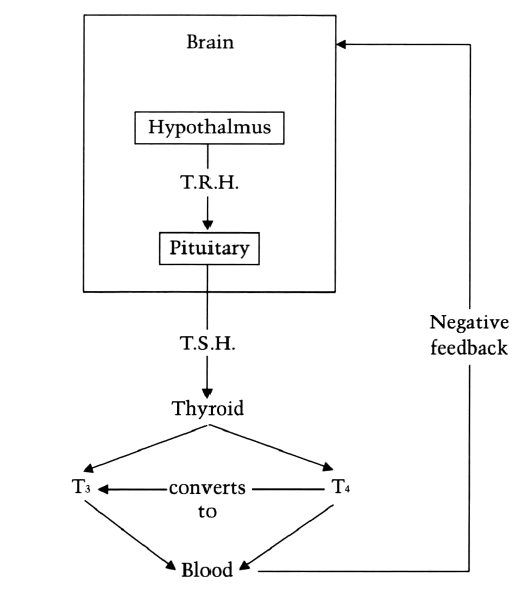
Figure 1: Thyroid control

Calcitonin
This hormone is also released by the thyroid. Its function is to regulate the blood level of calcium by reducing excessively high levels.

What are the Symptoms of Hypothyroidism?
As the thyroid influences every system, organ and muscle in the body, the potential list of symptoms is enormous. The pattern of symptoms a sufferer may experience depends on human individuality, which results from heredity, diet, immune efficiency and stress levels. Our genetic predisposition also plays an important role in influencing the systems and organs that may be disturbed by a thyroid deficiency.
However, there are certain leading symptoms that are common to the greater majority of patients, these are included in the table below.
Common symptoms of hypothyroidism
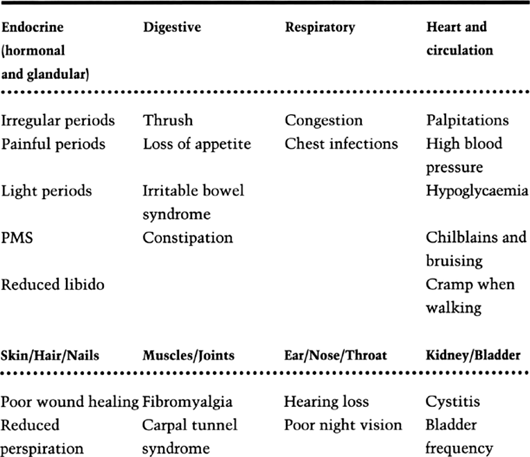
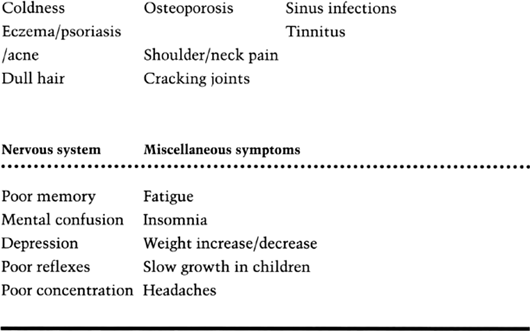
How is Hypothyroidism Tested?
Modern blood testing is seen as an essential component in diagnosing hypothyroidism. Doctors measure the amount of thyroxine (T4) and triiodothyronine (T3) to assess how well the gland is working. (They also measure free T4 and free T3.) Many doctors and researchers also measure the amount of TSH or thyrotropin in your blood stream. TSH is released when there is too little T4 so the more TSH you have in your body the more underactive your thyroid (and the less TSH the more overactive your thyroid).





